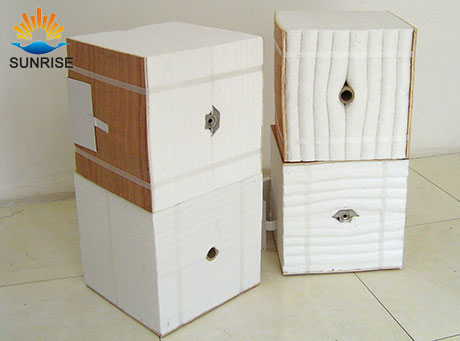The traditional conversion furnace lining uses heavy refractory materials and the outer wall is insulated with perlite. Due to the large volume density of heavy refractory materials, poor thermal insulation properties, high thermal conductivity, and lining thickness of about 300-350 mm, the external wall temperature of the equipment is very high, and a very thick external insulation is required. Due to the high humidity in the conversion furnace, cracking and even peeling of the inner lining, cracks sometimes penetrate the tower wall and shorten the service life of the cylinder. The following is the conversion furnace to use aluminum silicate refractory fiber brick liner, change the external insulation to internal insulation, the specific introduction is as follows.
1 Lined basic structure
The conversion furnace has a working pressure of 0.8 MPa, low gas flow rate, light flushing, and low medium temperature. These basic conditions provide the possibility of using aluminum silicate refractory fiber brick structures for the elimination of heavy refractories. This brick is used as the lining of the tower equipment, and it only needs to be pasted with the adhesive by stitching. In the pasting process, all sides of the brick should be coated with adhesive, and at the top of the head should also be used in combination with nail grabbing. To prevent shedding.
2 Construction essentials
(1) Derusting The rust on the inner wall of the tower should be clean and completely omitted.
(2) Paste The bricks in each manhole or process nozzle should be cut and no adhesive shall be applied.
(3) Repair After all of the paste is completed, it takes about 24 hours to perform the oven. At this time, the inner wall is repaired and the last time the binder is applied on the surface of the brick. This is very important.
(4) Oven According to the used oven fuel, a reasonable oven curve is designed to conduct the oven.
3 Advantages Compared with Heavy Refractories
(1) Energy-saving effect After using aluminum silicate fire-resisting fiber bricks, because of its excellent thermal insulation performance, small thermal conductivity, low heat loss, and low wall temperature, the catalyst temperature drop rate in the furnace is very small during short-term shutdown. , driving up fast, even without the use of electric stoves.
(2) Improvement of conversion furnace equipment capacity For converters of the same specification, the use of aluminosilicate fiber bricks for internal lining increases the effective volume of the tower by 40% compared to refractory bricks or castables, thereby increasing the catalyst loading and reducing the catalyst layer. Differential pressure improves equipment capabilities.
(3) Reducing the weight of the conversion furnace equipment Since the capacity of the aluminosilicate fiber bricks is 220~250kg/m3, the capacity of the refractory bricks or castables is not less than 2300kg/m3, which is 80% less than the use of heavy refractory materials for lining about.
(4) Reducing the external insulation thickness of the equipment Under certain conditions, a reasonable design of the thickness of the lining of the aluminum silicate fiber structure can reduce the thickness of the external insulation layer or even cancel the external insulation. In the blower recovery combustion chamber of another item designed by the author, Completely cancel the external insulation, the effect is very good.
(5) Reducing infrastructure investment The lighter weight of equipment reduces the amount of civil engineering work and reduces infrastructure investment.
(6) Facilitate Construction Since the volume per unit volume of the aluminum silicate fiber structure is only about 1/10 of the weight of the heavy refractory material, the labor intensity is greatly reduced, and the construction period is reduced by about 70% from that of brick or castable.
4 Material selection and oven system
(1) Materials High temperature adhesives are required to have strong adhesion at room temperature and high temperature, bonding time is 60 to 120 seconds, and high temperature compressive strength is high. Aluminosilicate refractory fiber bricks should meet the following conditions: bulk density 220~250kg/m3; slag content ≤ 5%; moisture content ≤ 1.5%, use temperature ≤ 1100°C.
(2) Oven system The oven can inspect the furnace heating, air circulation, water cooling system, working temperature and manufacturing quality, so we must establish a scientific and reasonable oven curve.


